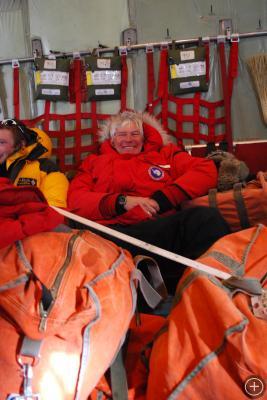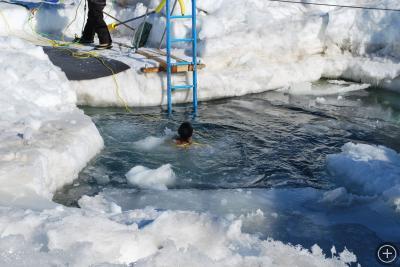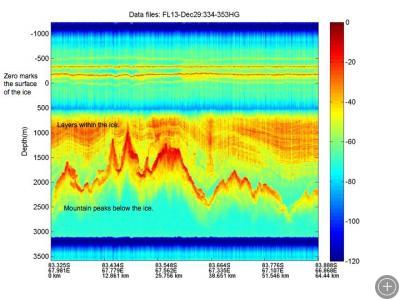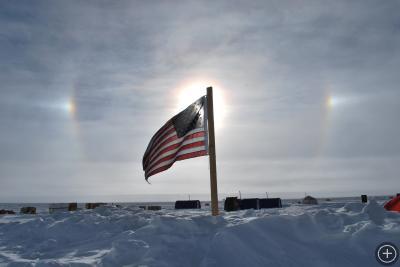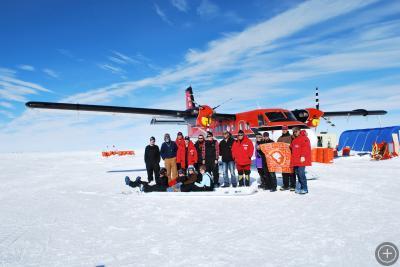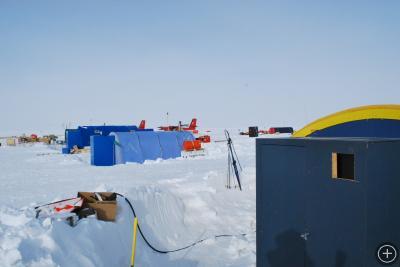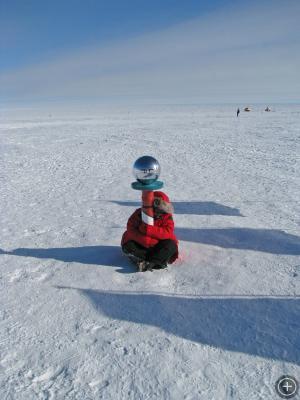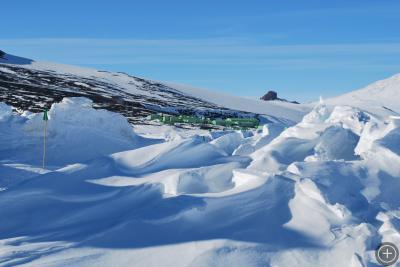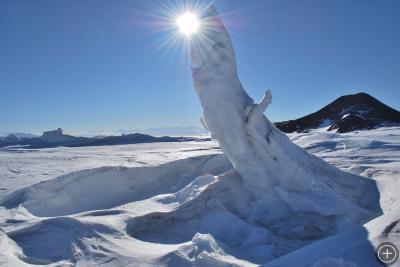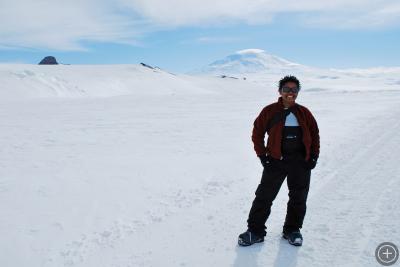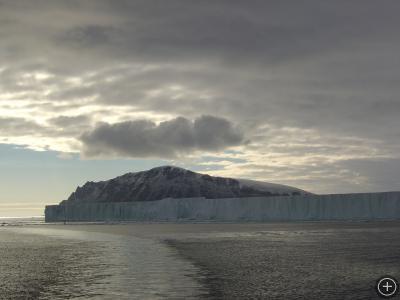MCMURDO STATION, ANTARCTICA– The problem with going to remote places is that no one wants to come pick you up. As of the 13th, we had a plan for finishing the survey, getting all the science personnel out of AGAP and leaving Antarctica on the HERC flight that left at 7am yesterday. Reality is: not a single member of the AGAP-South staff or science team was on that flight. Since the 13th we have been waiting for a ride out of East Antarctica, a ride that each day was promised and then taken away. The carps and electricians have it the worst. Their ride was supposed to come on the 13th, while the science team has just been waiting since the 15th or 16th. The funny thing is that the weather here was supposed to turn so foul and cold that we would not be able to get picked up at this time. It’s still a balmy -25F… normal AGAP summer temperatures.
Many of the HERC cancellations have had nothing to do with weather here at AGAP. The majority of flights were canceled because of mechanical problems and a few more were kept away by the forecast, not the actual weather. Last Tuesday, the HERC circled overhead and turned back to town without stopping. We later learned it had an engine failure that would prevent it from taking off again had it landed. That solace was not provided before the phrase “If a HERC circles twice and does not land, you’ve been AGAP’d” was added to the collection of poems, cultural arguments and witty limericks on the outhouse walls.
Yesterday morning, we were canceled again despite beautiful weather on the plateau. This particular HERC could not get appropriate air pressure in the passenger cabin. Normally, airplanes are kept at a pressure altitude of no more than 8000 ft, which is comfortable for most people when they are sitting or sleeping. Weather systems are often associated with pockets of high and low pressure. As they pass over, they change the pressure altitude or the amount of oxygen available in the air. Our science party has experienced pressure altitudes of near 16,000 ft while at AGAP. When they called to cancel the HERC because they couldn’t lower the altitude inside of it by pumping the plane full of oxygen, we all objected. Everything is downhill from AGAP! We are already at the maximum altitude we’d experience during flight and 2 days before we were 2,000 ft higher! Despite our exclamations, arguing with a HERC will never make it land. But later that night, a HERC finally landed! More importantly, it stopped, added 3,000 gallons of fuel to the AGAP fuel bladder and then hauled away with 20+ passengers and tons of cargo.

AGAP residents eagerly wait while cargo is loaded onto the HERC. Everyone was smiling and there was even some dancing… mostly because it was so cold.
Now back in McMurdo, the AGAP team will work to disassemble the science kit on the plane, pack, label and ship all our gear back to New York. Meanwhile, I am packing my personal things and coming to terms with going home — particularly since it will still be winter when I get there. A month in East Antarctica is plenty of winter for any year!
Not missing the cold of Antarctica does not save me from missing the adventure. As the reality of leaving this great continent dawned on me, I decided I had to throw myself in the deep end one more time: I took the polar plunge. Yes, I jumped into freezing cold, salty water in a cutaway in the ice shelf. It was surprising — like when we discovered one of the Recovery lakes is not a lake at all; it was cold, like the windy day on the plateau when the wind chill hit -55F and it was exhilarating — like all science fieldwork should be. What better way to end this journey of learning?
]]>AGAP-SOUTH CAMP, ANTARCTICA– On January 6th, we sat around after dinner discussing how miraculous it was that nothing had gone wrong. This clearly was the cosmic queue for everything to go wrong in the next 27 hours.
First, the inverter blew. The inverter supplies power for the scientific equipment in the plane. Without it, the gravimeter has no blinking lights and collects no data. This flight holds the current record for the shortest flight out of AGAP-south. Beth Burton noticed the lack of power and quickly turned SJB around.
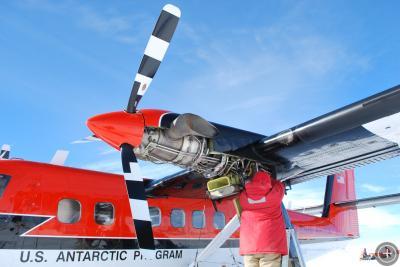
A KBA mechanic works on the left engine of SJB. The plane has been getting a lot of attention lately.
The very next flight, we lost the plane’s tip tanks. In addition to fuel stored near the belly of the plane, there are also gas tanks in the wings. These tip tanks add about 15 minutes of flying capability to any flight out of AGAP and were essential to meeting some of our distant science targets. It was particularly frightening that these pumps malfunctioned when we were considering flying the Recovery Lake lines, which require the use of the plane’s normal tank, the auxillary tank we installed back in McMurdo and the tip tanks.
Finally, in a third stroke of bad luck, we lost the onboard GPS. Without information from our Global Positioning System, we can collect data but we have no idea where we are along the survey line. We know the data represents the Earth… but where on Earth?
Thinking bad things come in 3’s might lead one to believe these would be the end of our troubles but the worst was yet to come. Next the “command center” of the radar system went out. It is as if you were using your home computer and suddenly, you could not see your hard drive anymore. You wouldn’t be able to save new documents, or play your favorite game. It is a situation best described by “Lights on but no one’s home”. Our science team discovered this problem just after I had gotten up for my “night shift” duties. Nick was able to replace the command center and we were still able to fly that day.
Later, in the radar processing, we saw strong vertical offset of the ice sheets internal layers and the bed that lies below. Nick and I set out to investigate this problem by examining an individual radar file from Flight 35, which seemed to be when the problem started. In the end, it turned out that after replacing the radar’s command center, the settings for channel 1 of the radar had been reset but the others (channel 2, 3 and 4) were not set correctly. This was a happy answer to the problem since it meant that we could rescue the data from flights 35-40 if we used channel 1. Not having worked as long or as hard on this project as either Nick, Michael or the PIs at times I feel like the hired help or the free loader who came along because she wanted to be in East Antarctic Field Camp with a population of 31. When I contributed to figuring out why the radar was malfunctioning, that increased my feeling of self worth. I had a moment in which I felt instrumental to ensuring the data quality… not just the making of copies.

This is what the radar looked like after the radar’s command center broke. Fortunately we found the source of this problem and will later be able to recover this data.
Despite all the unfortunate events, the survey has gone well and, I have to say it has gone by fast. It’s hard to believe that we only need 4 more days of good weather to complete our science objectives. It’s hard to put your faith in good weather to make plans for going home but we don’t have much choice. Here’s hoping for clear skies!
]]>AGAP-SOUTH CAMP, ANTARCTICA– Once we began flying at AGAP, we quickly got into a routine of collecting data, downloading, archiving and running a quality control procedure. We are operating 24 hours a day in two teams. There is almost always someone at the computer copying or reviewing data. Though there have been days that have been flawless, our peak performance of 4 flights per days has been interrupted by weather, which was particularly bad around the New Year.
Life at AGAP revolves around the forecast… which is not always the actual weather. The weather determines if we’ll be allowed to get off the ground and which direction we can point our airplane, SJB. Assuming the weather cooperates, a day in the science tent follows a certain rhythm, paced by the arrival and departure of SJB.
The day begins with the rising of our day shift operators, Nick and Michael. They pop into the science tent eager to know how things went the night before. The flight plan for that morning has usually been selected a day or two in advance. On the morning of the flight, it is relayed to the pilots and our flight operator, the scientist who makes sure all our equipment is up and running before and during the flight.
Thirty minutes before we leave the ground, our base stations have to be on. Base stations collect a similar type of data as equipment on the plane, but are in a fixed position just outside our science tent. We have base stations for the GPS and magnetic data. The GPS base station is required so we know where the plane is relative to camp. The magnetic base station is needed to capture how the magnetic field is varying in time, while SJB’s onboard system captures how the magnetic field varies in space. The Earth’s magnetic field varies in time in part because of currents in the liquid part of the core of the Earth (i.e. the liquid outer core). The magnetic field varies in space because of different rock types under the ice. By collecting data at the base station and onboard SJB, we are able to separate the changes in time, which we are not studying, from the changes in space which relate to the rocks we see on the radar lines.
While SJB is in the air, we are in the office making copies of the data. This is particularly time consuming for the radar data because of its volume. Copying the radar drives takes so long that we have one computer and one person, Chris, designated to the task. After the radar copy is complete, a sampling of the data is plotted and reviewed. Meanwhile, similar procedures are executed on the magnetic, GPS and laser data from the previous night’s flight. Although not an exciting aspect of the work, the QC (quality control) step is essential. It is during this step we identify survey lines that might need to be reflown and also get a sense of how well our system is working.
When the plane returns, it is greeted by a flurry of activity. The camp staff are ready to refuel, Chris or Nick will take blank hard drives out to the airplane and swap them for the ones containing the radar data for the flight, Stefan and Dan check on the status of the gravimeter. The flight operator brings in written logs and data on memory cards to archive and copy. The plane only sits unattended in between the day and night shift, while the whole camp is having dinner or on bad weather days.
The pace of the survey makes the days go by quickly. I keep forgetting that the GAMSEIS team is done with their work and gone already! I still expect them to come back from an installation and be sitting in the galley at dinner. With 4 flights a day, we are just barely keeping up with the in-flux of data, which is good because you need something to do in this place or you’ll feel trapped. Fortunately, I never feel trapped when surrounded by science!
]]>AGAP-SOUTH CAMP, ANTARCTICA– There are finally planes in the airspace of AGAP-South! We flew our first survey lines during the transit of scientists from Pole to our main camp. With the first flight, came the first observation of peaked bedrock under relatively thin ice. Thus far the radar shows the bedrock to be about 1.8 miles below the ice sheet surface and its elevation varies in some regions by up to half a mile. Hard to believe that just under this endless expanse of ice there are mountains. It’s such a secretive part of the world.
While our research group is here doing an airborne survey, another group based out of Penn State University is installing and servicing seismometers. The airborne side is called GAMBIT while the seismic side is called GAMSEIS. Together we are the AGAP project and the occupants of AGAP-South.
Unlike the work I am here to do, GAMSEIS is a multi-year project that began last year. Over the course of the project, whenever there is a large enough earthquake, waves of energy will pass through the earth and be recorded at the GAMSEIS seismic stations. The GAMSEIS group will return and collect their seismometers along with the record of seismic events. Using those data, they’ll be able to piece together the story underlying the Gamburtsev Subglacial Mountains. We’ll better understand how the mountains were built and the nature of the mantle, the molten layer of Earth, that lies below.
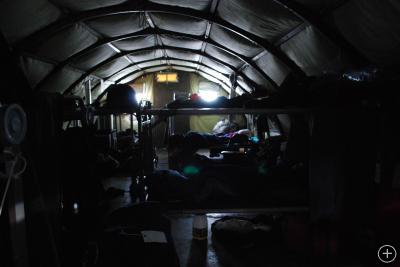
This is the inside of the Jamesway tent where the scientists sleep. It’s hot, crowded but somehow still a welcome change from being outdoors.
The weather on Christmas Day forced us to take a break and enjoy the holiday. Both science teams were grounded due to low visibility caused by blowing snow coming out of the South. Despite our 24-hour schedule, dinner at AGAP is the meal most of our population of 42 actually are awake and present to eat. It falls right between the morning flight and evening flight for both science groups and those working the night shift have usually just gotten up. Although one of the cooks is suffering a rib injury, Christmas Dinner was a meal to be reckoned with. It was also a great chance for the whole camp to relax and get to know each other individually rather than categorically as science, flight crew, or staff.
For me part of the holiday excitement was that those of us on the GAMBIT side got to share some of our first data products! We’ve waiting a long time to see these radar profiles with plenty of peaks! The days ahead hold a lot of the same, but there are still firsts and discoveries to be made. I wonder when we will find the biggest mountain peaks and the biggest lake!
]]>SUMMER CAMP, SOUTH POLE, ANTARCTICA– So, perhaps I was a bit ahead of schedule when I referred to Friday as the Eve of Discovery. Since then, AGAP has been playing the waiting game. Waiting to get to Pole, waiting to get acclimated at Pole, waiting to get to AGAP-South and now waiting for the rest of the science party to be medically cleared to fly our science missions.
In the midst of all that, I developed and recovered from the intestinal CRUD that was sweeping McMurdo. CRUD is the official term for whatever sickness is sweeping McMurdo in spite of the flu shots and constant handwashing. Initially, the doctors thought I was sick because I had taken Diamox, the recommended medication for altitude adjustment. When I was still eating tea and toast 3 days later, they decided I had had the CRUD. I slept through most of those uncomfortable days and being at Pole was just what I needed to forget being sick.
Eventually, I beat the CRUD and saw my name on the manifest to fly to Pole. We arrived just before midnight on December 18 for a planned 3 days of acclimatization at more than 10,000ft. When my illness resurfaced at Pole (CRUD part 2), I ended up having to stay 2 extra days. Most of my time was spent at Summer Camp, in the South Pole’s sturdy but temporary buildings called Jamesways. Although Summer Camp is a shantytown compared to South Pole Station, it was much more comfortable than I anticipated. We still have running water and plumbing, something I’ll be sure to miss at AGAP, and across from my little haven, there’s a lounge with 2 TVs and room to dance the night away if the spirit so moves you.
I was impressed with South Pole Station and since it had so many public spaces, I spent much of my time squatting in the quiet reading room or in one of the lounges where the walls are lined with books. The station manager, who also contributed to the design and construction of the building, gave the AGAP group a behind-the-scenes tour. We learned how the building is designed to recycle all the heat it generates and saw the many 4-wall doors that would be closed if ever there was a station meltdown. Unfortunately, being in such an extreme part of the planet, where the weather can kill you, also means you have to plan for the worst. Everything in the building is duplicated. Each heating system could heat the whole building if the other one broke or needed repair. And on top of that, part of the building is a life preserver; a small section where everything needed for survival can be produced and maintained even if the other parts had to be abandoned.

At the South Pole, I did the ever famous handstand. Everyone wants a chance to hang off the bottom of the world.
I spent most of my last day at South Pole in the growth chamber, a greenhouse within the station where all the vegetables are grown for those that winter-over. It’s also one of the few places you can track down some humidity in the dry polar air. I knew before I came to Antarctica that it was the highest, driest, windiest and coldest place on Earth. But I now have a new appreciation of the high and dry aspects of its character. It’s common for people to get sore throats at night, not because they are developing colds but because it is so dry, it desiccates the back of the throat. In the course of the night, it dries out until the pain of it wakes me up. For the first time in my life, I have taken to sleeping with my water bottle cradled in my hands. But that’s only one of many strange habits I have these days. My favorite is that I have to wear sunglasses to go to the bathroom. Who thinks “Man, I need to go to the bathroom. I better find my sunglasses!” Acclimatizing to life in this frozen wilderness is not too hard when you’re excited about the science but I know I’ll have a whole new appreciation for life in NYC when I get back.
]]>
Because being at high altitude can make some people sick, the science team has to be trained on multiple parts of the airplane’s science equipment.
During June this year, we tested our radar system in Greenland. We flew over the Greenland Ice Sheet, collecting data to image the ice down to 2.5 km (1.6 miles) below the lake-spotted surface. Now in Antarctica, we face the challenge of imaging more than 4 km of ice…. That’s 2.5 miles of frozen history between our science team and the Gamburtsev Mountains we came here to study! Because we have to reach further into the ice, we have more data than ever coming back after each flight. There’s so much data that the system chokes on it and gasps, “Help me, Adrienne. Help!”
I have escaped the office a few times this week. I got to go on a tour of the pressure ridges that form between the flowing ice of the Ross Ice Shelf and the rock that stands firm against it. And just last night, I escaped to Scott Base, the Antarctic Base that belongs to New Zealand, for some retail therapy. My Scott Excursion really took my mind off of the software for a while and had me refreshed and ready to go back to Radar World this morning. Not to mention I am well stocked on wooly base layers to fight the cold.
Today, I feel the same way I do when I am at the top of the big hill at the beginning of the ride. There’s that moment when you lift off your seat before powering down the steep hill, screaming your head off. I have been living there, in that emotional suspension for 3 days. Part of my jitteriness the last few days is undoubtedly rooted in the fact I’ll be going to the South Pole on Monday. According to our medical briefing, that means I’ll be perpetually short of breath, having trouble sleeping and going to the bathroom about every 20 minutes for 2 days…. The anticipation is almost too much to hold in! I have been to 10,000ft elevation before but that was after living at 6,500ft above sea level for 5 weeks… and that was in Utah. The transition from sea level here in McMurdo to 10,000ft is such a surprise to the system that everyone is prescribed a medication to help our bodies adjust to the lower oxygen levels. On top of that, we all have to fight off the adrenaline brought on by the fact we’re in Antarctica, at The South Pole, at 10,000ft—no offense to Utah, but it doesn’t compare! Just in case we don’t adjust to the elevation, everyone has been learning tasks outside their specialty. Hopefully, if someone gets sick, we’ll be able to keep the science moving forward, even if at a slower pace.
In the end, it’s not just where we’ll be a week from now. It’s what we’ll learn. The Gamburtsev Mountains have been enigmatic since their happenstance discovery in 1958. Soon, we’ll know them in a way only dreamt of until now. The people on this science team will learn more about the Mountains than the rest of the world has compiled in the last 50 years. This is the Eve of Discovery.
]]>Since I was on a cruise for the duration of my last trip, I never had to cross one of the unifying stepping stones of everyone who works here, be them firemen or astronomers: I didn’t go to snow school. Snow School, or Happy Camper, is an overnight trip to the ice during which those new to Antarctica learn basic survival skills and come to appreciate some of the subtle differences between camping in the Midwest and camping on an ice sheet. My trip began December 2, with 17 other students in tow. The morning was spent listening to lectures but in the afternoon we walked out to the Happy Camper supply shed and began to set up camp. Right as we headed outside, it began to snow again!
After we had learned the basics of different shelters one can build on the ice, we were left to our own devices. During that time, our only responsibility was to cook dinner in our snow kitchen. Building in the snow, it is easier to build down than up. We began by expanding the kitchen so that there would be benches on either side of the preparation area. In the end, the area was able to accommodate at least 15 people at a time, allowing them to sit out of the wind and enjoy a hot beverage or some re-hydrated meals.
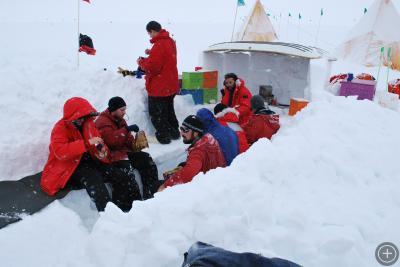
Eating our re-hydrated dinners in the kitchen we built by digging down into the snow. I slept in one of the Scott Tents in the background.
The food at our snow camp was not at all fresh or good! Amongst our rations for the evening we found a chocolate bar that was dated 13 years ago!
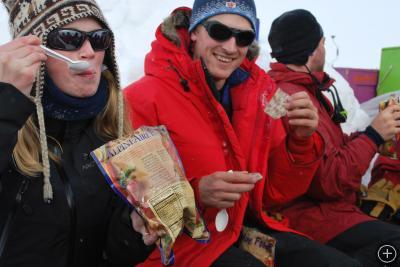
Amongst our food rations, we found a chocolate bar that expired 13 years ago. Here, Tim smiles before trying the chocolate. He was not smiling after.
Another group of creative individuals decided to build an arch out of snow. I helped in the beginning, popping the blocks of snow out of the quarry and also was there to assist in placing the keystone block which supports the weight of the arch, but much of the work was done while I was off cross country skiing for the first time in my life!
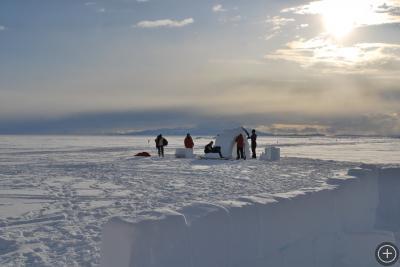
Happy Campers putting the finishing touches on our snow arch. At about 11pm the sun came out and smiled its approval on our construction.
When the time came, I chose to sleep in a Scott Tent, the design of which is over 100 years old. Having recently read about the early Antarctic explorers during my layover in Christchurch, I thought I would try-on a piece of their lifestyle. The tent has 4 poles that form a square base and meet at the top in a pyramid. Unlike modern tents, the base is not attached. It’s just a tarp you throw over the snow after the exterior has been propped up. We learned how to dig into the snow to make anchors for the tent that would neither rip it nor let it blow away. I can’t say I was particularly warm in the Scott tent, but I wasn’t any colder than the last time I went camping in Pennsylvania in April.
Even if I get to return to the Ice and become a Happy Camper once more, it will never be the same. The people I spent the night playing in the snow with are pretty amazing folks. And this experience alone was worth coming halfway around the world.
]]>NEW YORK CITY, NEW YORK– In New York City, fall is just beginning its descent into winter. Last night we sank below 40 degrees for the first time and back in my hometown of Columbus, Ohio, it’s beginning to snow. Each time I clutch my scarf a little tighter to protect me from the wind, I try to tell myself to toughen up. I think, “This time next week, you’ll be in Antarctica, sleeping in a snow cave. This time next month you’ll be at AGAP South, where it’s 40 degrees below zero on the most pleasant day.”
While on the subway, I try to imagine a temperature 80 degrees different from today’s and picture myself doing undergraduate fieldwork under the unrelenting sun and heat of a Utah summer. The train stops suddenly and brings me back to NYC… “There are more people in this subway car than there will be at AGAP South.” I look around, noting the diversity: colors, expressions, ages and occupations. It seems the same reason I love living in NY is the same reason I love leaving it. The variety. You can’t beat a career that takes you from “The Top of the Rock” in midtown Manhattan to the bottom of the world.
I’ll arrive on the Ice Monday, November 24… See you there!
]]>
